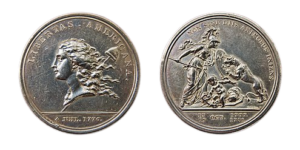Benjamin Franklin’s Masterpiece: The Libertas Americana Medal
Posted onThe Libertas Americana medal, conceived and authorized by Benjamin Franklin, was a tribute to American independence and France’s support in that valiant endeavor. The medal’s dramatic imagery on the reverse symbolically retells the story of the American Revolution, with the dates 1777 and 1781 inscribed to represent the two greatest American victories at the Gates of Saratoga and Washington at Yorktown.
Notably, Franklin commissioned the creation of this medal on his own, not on the authority of the Continental Congress. French artist Augustin Dupré designed the medal according to specifications from Benjamin Franklin. The medal was struck in Paris, as our young nation had no minting facility at that time that was able to produce such detailed work. The dies were completed in 1782 and the first medals were struck in 1783.
Today, the exceptional Libertas Americana medal is valuable and highly prized. It is legendary throughout American numismatic circles and beyond, not only for its historical significance and its arresting grandeur, but for the fact that Franklin personally handled each of these medals.
In April and May 1783, Franklin mailed his medals to recipients’ far and wide in the United States, France and beyond, including to members of George III’s government and the Grand Master of the Knights of Malta. Franklin also mailed a bundle of his medals to Philadelphia to distribute to the members of Congress, including a silver one for Congress’ president and future Mint Director Elias Boudinot. Indeed, his postal accounts reveal that in April 1783 he twice hired a carriage to special deliver his medal to the recipients.
Those who received the medals cherished them and Franklin’s mailbox filled up with thank you notes from across the continent. Thomas Jefferson had one on display at Monticello, inventoried as “a medal by Dr. Franklin.” The renowned Dutch artist and mint master Johann-Georg Holtzhey implored a friend to write to John Adams to inquire how he and his friends could obtain one. While not officially a part of the Comitia Americana medals, the Libertas Americana medal has been included in this group ever since Thomas Jefferson chose to place one in George Washington’s set of Comitia Americana medals in 1789.
On the medal’s reverse, the celebrated narrative features the infant Hercules, who represents the United States of America. A leopard, representing England, leaps with two serpents to attack Hercules. A fully armed Minerva, representing France, defends baby Hercules while he strangles the two serpents, under her protection, in fully struck detail.
The medal’s obverse features a head of Liberty with flowing hair, facing right, a freedman’s cap atop a pole in the background. This was used as the inspiration for some of the U.S. Pattern coinage of 1792 and for the first U.S. Half Cents in 1793.
Silver versions of the Libertas Americana medal are extremely rare. Bronze versions are more common but still valuable and highly coveted. Most survivors today were owned by non-collectors who cherished these meaningful medals, and they were often handled, displayed and cleaned, so today few exist in Gem condition.
Want to read more? Subscribe to the Blanchard Newsletter and get our tales from the vault, our favorite stories from around the world, and the latest tangible assets news delivered to your inbox weekly.







